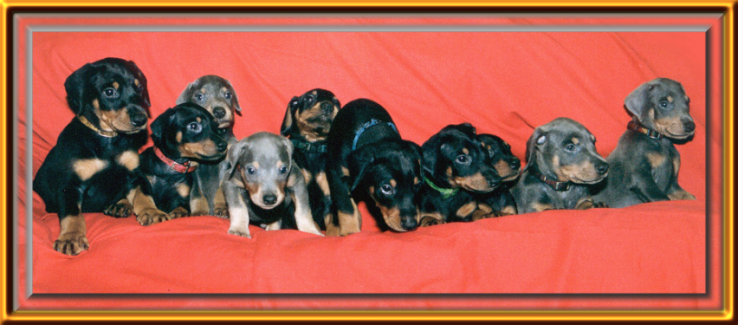

 Doberman
pinscher breed standard
Doberman
pinscher breed standard
&
breed history

DOBERMAN PINSCHER
Doberman (also called Dobermann)
Advantages
*Alert
*Brave
*Loyal
*Good guard dog
*Intelligent
The Doberman is a strong, alert guard that enjoys the comforts of a home. It
will protect its family with its life. The Doberman usually overcomes any
opponent and is one of the best guard dogs in the world. It takes its
responsibilities seriously, is skilled at tracking and makes a fine police or
obedience dog.
SIZE
Height - Male:27 in (68.5cm) at the withers, Feamale:25 1/2 in (64 cm)
Weight - males 80 - 95 pounds, females 65 - 80 pounds
EXERCISE
Give the doberman at least 40 minutes of exercise each day.
GROOMING
This dog needs little grooming. Nails trimmed every couple of weeks. Use a
rubber mitt to groom the dogís coat and spray dog cologne and rub it in with a
silk towel. Clean ears when needed. Bath when needed.
FEEDING
Feed 2x a day use the amount to feed on the dog food bag.
ORIGIN AND HISTORY
Her Louis Karl Dobermann was a tax collector during the 1880s, in Germany. He
decided to breed a fierce dog to accompany him on his rounds. He wanted a medium
to large dog, short-coat, easy to maintain, with courage, alertness and stamina.
It was not a hard task for him because he was keeper of local dog pound and had
access to numerous strays.
The existing German Pinscher was aggressive and alert, so it was around this
breed doberman founded his stock. He introduced the Rottweiler, a dog with great
stamina and tracking ability, and the Manchester Terrier. It is probably from
the Manchester Terrier that the Doberman obtained its gleaming coat and black &
tan markings. The pointer may also has been used. Her Louis Doberman did not
keep any writing on his breeding of Doberman, so we donít know exactly what and
how many different breeds were used to produce the Doberman of this days - some
say that probably 15 - 18, but nobody knows for sure.
SHOW REQUIREMENTS
GENERAL APPEARANCE:
A well-set body. Muscular and elegant, with proud carriage and bold. Alert
temperaments. Form compact and tough. Capable of speed. Gait light and elastic.
Eyes show intelligence and firmness of character. Shyness or viciousness heavily
penalized by show judges.
COLOR:
Colors allowed are Blacks, Browns (called Red); Blue and Fawn (called also
Isabella) all with rust red markings. Markings sharply defined, appearing above
each eye and on the muzzle, throat and fore chest, on all legs, feet and below
the tail. White markings undesirable.
HEAD AND SKULL:
Proportionate to the body. Long, filled out under the eyes. Clean cut. Resembles
a blunt wedge. Top of the skull flat with a slight stop. Muzzle line extends
parallel to the top line of the skull. Cheeks flat and lips tight. Nose black in
black dogs, dark brown in brown dogs and dark gray in blue dogs.
TAIL:
Docked at the first or second joint. Appears as a continuation of the spine,
without material drop.
FEET:
Forefeet arched, compact, not turning in or out. All declaws removed. Long, flat
paws and weak pasterns penalized. Hind feet arched. Compact and catlike.
TEETH:
Sscissors bite. Four or more missing teeth or an undershot or overshot jaw is
disqualifying.

Please, sign my Guestbbook.
Thank You for signing my Guestbook.